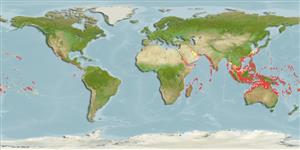Teleostei (teleosts) >
Perciformes/Scorpaenoidei (Scorpionfishes) >
Scorpaenidae (Scorpionfishes or rockfishes) > Scorpaeninae
Etymology: Scorpaenopsis: Latin, scorpaena = a kind of fish, 1706 + Greek, opsis = appearance (Ref. 45335).
More on author: Cuvier.
Environment: milieu / climate zone / depth range / distribution range
Ecology
Marine; reef-associated; depth range 1 - 70 m (Ref. 559). Tropical; 32°N - 26°S
Indo-Pacific: Red Sea and East Africa to the Hawaiian Islands and French Polynesia, north to southern Japan, south to the Great Barrier Reef and New Caledonia.
Size / Weight / Age
Maturity: Lm ? range ? - ? cm
Max length : 30.0 cm TL male/unsexed; (Ref. 9710)
Dorsal spines (total): 12; Dorsal soft rays (total): 8 - 10; Anal spines: 3; Anal soft rays: 5 - 6. Pectoral fin rays usually 18; back arched; with about 45 vertical scale rows; lachrymal bone with 2 or 3 spines over maxillary, first points forward, followed by 1 or by 2 close-set spines which point down and back; suborbital ridge with 4 or more spinous points, usually more than 8 or 10 points, not in a row and of various sizes; a shallow pit below front corner of eye (Ref. 10482). Colorful inside the pectoral fins, used for display (Ref. 48635).
Relatively an uncommon inhabitant of rubble or weedy coralline-rock bottoms of reef flats and lagoon and seaward reefs (Ref. 9710). Benthic (Ref. 58302). Feeds on fishes (Ref. 89972). Flashes its inner pectoral fins when disturbed (Ref. 9710). Can inflict a painful injury with its venomous dorsal sting. Often partly buried (Ref. 48635). Solitary or in pairs (Ref 90102).
Life cycle and mating behavior
Maturity | Reproduction | Spawning | Eggs | Fecundity | Larvae
Randall, J.E and W.N. Eschmeyer, 2001. Revision of the Indo-Pacific scorpionfish genus Scopaenopsis, with descriptions of eight new species. Indo-Pac. Fish. (34):79 p. (Ref. 42181)
IUCN Red List Status (Ref. 130435: Version 2024-2)
Human uses
Fisheries: commercial; aquarium: commercial
Tools
Special reports
Download XML
Internet sources
Estimates based on models
Preferred temperature (Ref.
123201): 24.6 - 29, mean 27.7 °C (based on 1060 cells).
Phylogenetic diversity index (Ref.
82804): PD
50 = 0.5000 [Uniqueness, from 0.5 = low to 2.0 = high].
Bayesian length-weight: a=0.01288 (0.00620 - 0.02676), b=3.03 (2.86 - 3.20), in cm total length, based on LWR estimates for this (Sub)family-body shape (Ref.
93245).
Trophic level (Ref.
69278): 3.8 ±0.58 se; based on food items.
Resilience (Ref.
120179): Medium, minimum population doubling time 1.4 - 4.4 years (Preliminary K or Fecundity.).
Fishing Vulnerability (Ref.
59153): Low vulnerability (20 of 100).
Nutrients (Ref.
124155): Calcium = 50.7 [26.8, 101.9] mg/100g; Iron = 0.627 [0.330, 1.605] mg/100g; Protein = 18.2 [16.2, 20.2] %; Omega3 = 0.219 [0.098, 0.606] g/100g; Selenium = 30.1 [16.1, 76.6] μg/100g; VitaminA = 205 [70, 584] μg/100g; Zinc = 1.08 [0.74, 1.58] mg/100g (wet weight);
